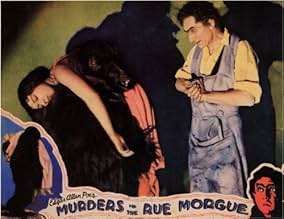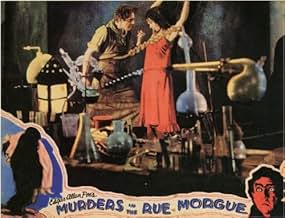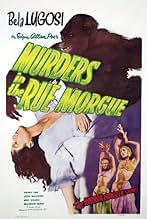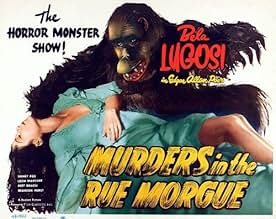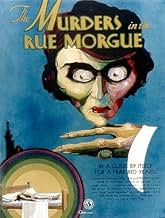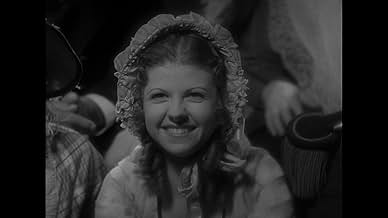CALIFICACIÓN DE IMDb
6.3/10
5.8 k
TU CALIFICACIÓN
Un científico loco busca mezclar sangre humana con la de un simio y recurre al secuestro de mujeres para sus experimentos.Un científico loco busca mezclar sangre humana con la de un simio y recurre al secuestro de mujeres para sus experimentos.Un científico loco busca mezclar sangre humana con la de un simio y recurre al secuestro de mujeres para sus experimentos.
- Dirección
- Guionistas
- Elenco
- Premios
- 2 premios ganados en total
Leon Ames
- Pierre Dupin
- (as Leon Waycoff)
Ted Billings
- Sideshow Spectator
- (sin créditos)
Herman Bing
- Franz Odenheimer
- (sin créditos)
Joe Bonomo
- Gorilla
- (sin créditos)
Agostino Borgato
- Alberto Montani
- (sin créditos)
Iron Eyes Cody
- Indian at Sideshow
- (sin créditos)
Christian J. Frank
- Gendarme Using Snuff
- (sin créditos)
Charles Gemora
- Erik, the Gorilla
- (sin créditos)
Harrison Greene
- Sideshow Barker
- (sin créditos)
Charlotte Henry
- Blonde Girl in Sideshow Audience
- (sin créditos)
Opiniones destacadas
I won't go into the plot details as many have done that before me, but "Murders in the Rue Morgue" is worth a look for several reasons.
The first is the overall look of the film from legendary DP Karl Freund (Dracula, Metropolis, and many others). The sets are outstanding, the lighting is great, and the overall atmosphere is perfect. Everything comes off as some creepy nightmare.
The second reason to see "Murders" is Bela Lugosi, who owns every scene he is in. He is sufficiently strange and intimidating as the mad doctor.
The third reason is the overall story line. OK, forget the whole mixing of the ape and human blood thing and this movie is very similar in plot line to "The Cabinet of Dr. Caligari", just substitute the ape for Cesare the Somnambulist. It also contains some very strong (for its time) scenes involving the doctor "administering" to his patients.
OK, now some things that aren't so hot.
First, the cutting between the man in the ape suit and the real ape's face is distracting. The shots don't match and some serious suspension of disbelief is required for this not to be a deal breaker. I've heard that Florey's film was cut against his wishes to add these scenes and remove others. That would explain why these scenes seem out of place.
Also, as others have referred to, the comic relief is really not very good. At the time, however, this type of thing was common in films that were thought to be very intense. The comedy was used to relieve the tension so the audience could be set up for the next batch of horrors. Most of it doesn't work in this film.
Overall, I felt this film was well worth a look, and I've watched it several times just to admire the outstanding work of Karl Freund.
The first is the overall look of the film from legendary DP Karl Freund (Dracula, Metropolis, and many others). The sets are outstanding, the lighting is great, and the overall atmosphere is perfect. Everything comes off as some creepy nightmare.
The second reason to see "Murders" is Bela Lugosi, who owns every scene he is in. He is sufficiently strange and intimidating as the mad doctor.
The third reason is the overall story line. OK, forget the whole mixing of the ape and human blood thing and this movie is very similar in plot line to "The Cabinet of Dr. Caligari", just substitute the ape for Cesare the Somnambulist. It also contains some very strong (for its time) scenes involving the doctor "administering" to his patients.
OK, now some things that aren't so hot.
First, the cutting between the man in the ape suit and the real ape's face is distracting. The shots don't match and some serious suspension of disbelief is required for this not to be a deal breaker. I've heard that Florey's film was cut against his wishes to add these scenes and remove others. That would explain why these scenes seem out of place.
Also, as others have referred to, the comic relief is really not very good. At the time, however, this type of thing was common in films that were thought to be very intense. The comedy was used to relieve the tension so the audience could be set up for the next batch of horrors. Most of it doesn't work in this film.
Overall, I felt this film was well worth a look, and I've watched it several times just to admire the outstanding work of Karl Freund.
Murders In The Rue Morgue casts Bela Lugosi as one of the many mad scientists he played in his long career. To make ends meet he has a carnival act, but it's really a blind for some gruesome experiments involving sex. InterSpecies sex that is.
If Charles Darwin is correct and man is related to the other primates than it follows, reasons Bela apes should be looking to mate with man given the proper stimulation. So for his horny gorilla he kidnaps women and injects them with simian blood. In the Paris of 1845 Bela's experiments are working pretty good as his ape is let loose on these injected women and the young women of Paris are in danger. Women of all classes as streetwalker Arlene Francis discovers to her tragic regret.
King Kong never eyed Fay Wray with more lust than Bela's simian had when he was checking out Sidney Fox. In fact King Kong should prove the hypothesis Lugosi was advancing. The climax of Murders At The Rue Morgue is very similar to King Kong with Leon Ames playing the Bruce Cabot part.
Some really great sets and beautiful cinematography are the main attraction of Murders At The Rue Morgue which bares only the slightest resemblance to Edgar Allan Poe's story. Lugosi is fabulously sinister and lustful, he's checking out Fox and the others himself. It's not Dracula for him, but what is?
If Charles Darwin is correct and man is related to the other primates than it follows, reasons Bela apes should be looking to mate with man given the proper stimulation. So for his horny gorilla he kidnaps women and injects them with simian blood. In the Paris of 1845 Bela's experiments are working pretty good as his ape is let loose on these injected women and the young women of Paris are in danger. Women of all classes as streetwalker Arlene Francis discovers to her tragic regret.
King Kong never eyed Fay Wray with more lust than Bela's simian had when he was checking out Sidney Fox. In fact King Kong should prove the hypothesis Lugosi was advancing. The climax of Murders At The Rue Morgue is very similar to King Kong with Leon Ames playing the Bruce Cabot part.
Some really great sets and beautiful cinematography are the main attraction of Murders At The Rue Morgue which bares only the slightest resemblance to Edgar Allan Poe's story. Lugosi is fabulously sinister and lustful, he's checking out Fox and the others himself. It's not Dracula for him, but what is?
Having decided not to do the Frankenstein monster, Bela's next film for Universal was this rather stagey thriller about a demented doctor trying to mix the blood of an ape with a virgin. The story is a bit far-fetched, and Lugosi is as over-the-top as he can get, but for the most part the film is good, solid entertainment. The film is a bit slow, and its has no music in the background. Add to this some stoic acting on the part of the cast as a whole(Lugosi excepted of course)and some frequent, flat direction from Florey(say that a few times quickly). Florey shows flashes of brilliance(many of them coming through the magic of Karl Freund's camerawork) with scenes such as Lugosi's pitch in the carnival tent, Lugosi murdering a street prostitute, and the finale of Paris above ground. Florey is also remarkably mundane in many scenes too, adding little depth to many of the characters as well as not creating enough suspense where always needed. Florey does deliver more often than not, however. This film is a good example of the traditional Universal horror film, as well as vehicle to display the talents of one Bela Lugosi. Look for Arlene Francis(of What's My Line fame) as a prostitute tied to a cross of woodbeams(possibly one of the best sequences in the film).
The early 1930s was very much a transition period for cinema. Armed with the newly-adopted technology of "talking pictures" and not really knowing what to do with it, many filmmakers stumbled through the first years of the sound era, gradually finding their feet as more and more established and emerging talents demonstrated exactly what could be done with these advanced storytelling tools. 'Murders in the Rue Morgue (1932)' seems to be very much a product of this learning process, and the truth is that the film is marred horribly by poor acting, often-ludicrous dialogue, a shabbily-edited narrative structure and a giant gorilla that switches periodically between a man in a monkey-suit and a real chimpanzee. However, it would be unfair to attribute these problems solely to the era, as many filmmakers were at this time already creating memorable cinema: in terms of the horror genre, James Whale's 'Frankenstein (1931)' and 'The Invisible Man (1933)' both adapted from classic literature today remain remarkable pictures that have lost little of their intelligence and brilliance.
There are two avenues through which 'Murders in the Rue Morgue' retains a certain air of respectability. The cinematography of Karl Freund, a veteran of German Expressionism, makes the film, if little else, visually interesting, and the climactic rooftop chase is vaguely reminiscent of Robert Wiene's 'The Cabinet of Dr. Caligari (1920).' This sequence, not unexpectedly, also calls 'King Kong (1933)' to mind, and I wonder if Cooper and Schoedsack perhaps looked in the direction of this film as inspiration for their final act in New York. One of Freund's gloriously-inspired shots sees the movie camera attached to Sidney Fox's swing, as she oscillates back and forth while in conversation with her boyfriend; just like the virtuoso first-person perspective in Rouben Mamoulian's 'Dr. Jekyll and Mr. Hyde (1931),' this single shot demonstrates an inventiveness uncommon in film-making prior to the 1940s. Without the restrictions of the Production Code, which wouldn't be actively enforced until 1934, Robert Florey sprinkles the story with some moments of unexpected violence, though Universal reportedly enacted their own form of censorship, removing around twenty minutes of footage.
The second component of the film that merits attention is certainly the acting of Hungarian Bela Lugosi, who had recently secured fame as the infamous Count in Tod Browning's 'Dracula (1931).' Though his performance isn't "great," as many have put it, his interpretation of Dr. Mirakle brims with a ghoulish enthusiasm for theatrics, and the overblown portrayal works well with Karl Freund's exaggerated visuals. Lugosi does his very best to maintain our interest in the film, but most of the remaining actors appear to be actively working against him: Leon Ames (credited as Leon Waycoff) is mostly unconvincing in his role as the heroic medical student turned sleuth, and Bert Roach is almost painfully inadequate as the "comic relief" sidekick. Not much is demanded of actress Sidney Fox, but she is suitably pretty and vulnerable to fit the bill, and I did enjoy D'Arcy Corrigan as the gruesome and corrupt morgue-keeper. Charles Gemora, who built an entire career from making a monkey of himself, plays Erik the Gorilla; apparently Universal's orangutans were in short supply.
There are two avenues through which 'Murders in the Rue Morgue' retains a certain air of respectability. The cinematography of Karl Freund, a veteran of German Expressionism, makes the film, if little else, visually interesting, and the climactic rooftop chase is vaguely reminiscent of Robert Wiene's 'The Cabinet of Dr. Caligari (1920).' This sequence, not unexpectedly, also calls 'King Kong (1933)' to mind, and I wonder if Cooper and Schoedsack perhaps looked in the direction of this film as inspiration for their final act in New York. One of Freund's gloriously-inspired shots sees the movie camera attached to Sidney Fox's swing, as she oscillates back and forth while in conversation with her boyfriend; just like the virtuoso first-person perspective in Rouben Mamoulian's 'Dr. Jekyll and Mr. Hyde (1931),' this single shot demonstrates an inventiveness uncommon in film-making prior to the 1940s. Without the restrictions of the Production Code, which wouldn't be actively enforced until 1934, Robert Florey sprinkles the story with some moments of unexpected violence, though Universal reportedly enacted their own form of censorship, removing around twenty minutes of footage.
The second component of the film that merits attention is certainly the acting of Hungarian Bela Lugosi, who had recently secured fame as the infamous Count in Tod Browning's 'Dracula (1931).' Though his performance isn't "great," as many have put it, his interpretation of Dr. Mirakle brims with a ghoulish enthusiasm for theatrics, and the overblown portrayal works well with Karl Freund's exaggerated visuals. Lugosi does his very best to maintain our interest in the film, but most of the remaining actors appear to be actively working against him: Leon Ames (credited as Leon Waycoff) is mostly unconvincing in his role as the heroic medical student turned sleuth, and Bert Roach is almost painfully inadequate as the "comic relief" sidekick. Not much is demanded of actress Sidney Fox, but she is suitably pretty and vulnerable to fit the bill, and I did enjoy D'Arcy Corrigan as the gruesome and corrupt morgue-keeper. Charles Gemora, who built an entire career from making a monkey of himself, plays Erik the Gorilla; apparently Universal's orangutans were in short supply.
A crazed scientist commits vile MURDERS IN THE RUE MORGUE to promote his theories concerning the relationship between human & ape biology.
Bela Lugosi dominates this rather fascinating little foray into terror, his mad mesmerizing eyes & theatrical gestures a natural complement to the film's Grand Guignol qualities. Listening to the world of weariness in his voice as he delivers a line like `Will my search never end?' makes only more poignant this fine actor's eventual descent into drug addicted obscurity.
Pert, pretty little Sidney Fox -she actually receives top billing over Lugosi - gives a pleasing performance as the unfortunate choice of the ape's interest (the plot is never really clear as to what, exactly, Lugosi is attempting to accomplish with his gruesome experiments). Leon Waycoff is hopeless as a romantic lead, but with an eventual name change to Leon Ames, he was to become one of Hollywood's most durable character actors.
The supporting cast is quite good: plump Bert Roach as a nervous medical student; sepulchral D'Arcy Corrigan as a sardonic morgue keeper; Arlene Francis, who has the dubious honor of featuring in one of Universal's most horrific murder scenes; and Noble Johnson, important Black actor & silent film star, here performing in whiteface (as he often did) as Lugosi's mute henchman.
Movie mavens will spot some familiar faces in unbilled roles: Harry Holman as Miss Fox's silly, obese landlord; Herman Bing, Torben Meyer & Agostino Borgato as three ear-witnesses to one of the murders; Tempe Pigott as an old crone with very bad teeth; and Charlotte Henry as a lovely young lady.
Based somewhat loosely on the classic detective story by Edgar Allan Poe, the film also owes much in plot to Leroux' The Phantom of the Opera and in style to Wiene's THE CABINET OF DR. CALIGARI. Karl Freund's cinematography is first rate, as is the expressionistic set design by Herman Rosse, with buildings tilted or leaning at crazed angles. The contribution of master makeup artist Jack Pierce is also evident.
Bela Lugosi dominates this rather fascinating little foray into terror, his mad mesmerizing eyes & theatrical gestures a natural complement to the film's Grand Guignol qualities. Listening to the world of weariness in his voice as he delivers a line like `Will my search never end?' makes only more poignant this fine actor's eventual descent into drug addicted obscurity.
Pert, pretty little Sidney Fox -she actually receives top billing over Lugosi - gives a pleasing performance as the unfortunate choice of the ape's interest (the plot is never really clear as to what, exactly, Lugosi is attempting to accomplish with his gruesome experiments). Leon Waycoff is hopeless as a romantic lead, but with an eventual name change to Leon Ames, he was to become one of Hollywood's most durable character actors.
The supporting cast is quite good: plump Bert Roach as a nervous medical student; sepulchral D'Arcy Corrigan as a sardonic morgue keeper; Arlene Francis, who has the dubious honor of featuring in one of Universal's most horrific murder scenes; and Noble Johnson, important Black actor & silent film star, here performing in whiteface (as he often did) as Lugosi's mute henchman.
Movie mavens will spot some familiar faces in unbilled roles: Harry Holman as Miss Fox's silly, obese landlord; Herman Bing, Torben Meyer & Agostino Borgato as three ear-witnesses to one of the murders; Tempe Pigott as an old crone with very bad teeth; and Charlotte Henry as a lovely young lady.
Based somewhat loosely on the classic detective story by Edgar Allan Poe, the film also owes much in plot to Leroux' The Phantom of the Opera and in style to Wiene's THE CABINET OF DR. CALIGARI. Karl Freund's cinematography is first rate, as is the expressionistic set design by Herman Rosse, with buildings tilted or leaning at crazed angles. The contribution of master makeup artist Jack Pierce is also evident.
¿Sabías que…?
- TriviaMany censors cut parts of the death scenes of the woman (Arlene Francis) of the streets - eliminating her stabbing and being tied to the cross beams.
- ErroresIn many scenes, the close-up of a chimpanzee is used for the gorilla.
- Citas
Dr. Mirakle: [Responding to an audience member who has accused him of heresy] Heresy? Do they still burn men for heresy? Then burn me monsieur, light the fire! Do you think your little candle will outshine the flame of truth?
- Créditos curiososAt the end of the film, the cast list is shown again with the heading, "A GOOD CAST IS WORTH REPEATING...."
- Versiones alternativasWhen originally released theatrically in the UK, the BBFC made cuts to secure a 'A' rating. All cuts were waived in 2001 when the film was granted a '12' certificate for home video.
- ConexionesEdited into Mondo Lugosi - A Vampire's Scrapbook (1987)
Selecciones populares
Inicia sesión para calificar y agrega a la lista de videos para obtener recomendaciones personalizadas
Detalles
- Fecha de lanzamiento
- País de origen
- Idiomas
- También se conoce como
- Ubistva u ulici Morg
- Locaciones de filmación
- Productora
- Ver más créditos de la compañía en IMDbPro
Taquilla
- Presupuesto
- USD 190,000 (estimado)
- Tiempo de ejecución
- 1h 1min(61 min)
- Color
- Relación de aspecto
- 1.37 : 1
Contribuir a esta página
Sugiere una edición o agrega el contenido que falta


